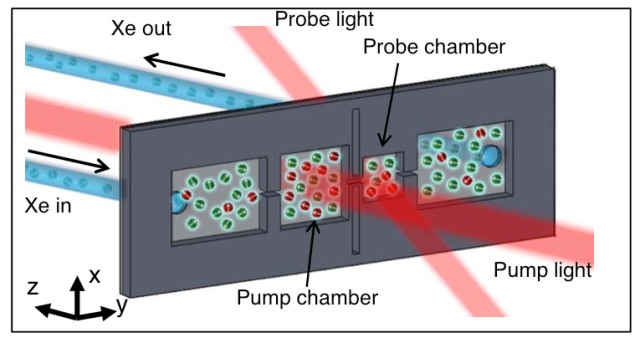While big machines were once the stuff that scientific dreams are made of, analytical spectroscopy instrumentation has trended to smaller products that are portable, affordable, and fit into locations far removed from a standard laboratory, such as the back of an ambulance or inside a chemical reactor.
 In this experimental set-up, unpolarized xenon gas goes in and hyperpolarized xenon gas emerges from a microfluidic chip when the gas becomes polarized through spin exchange with optically pumped rubidium atoms in the chip.
In this experimental set-up, unpolarized xenon gas goes in and hyperpolarized xenon gas emerges from a microfluidic chip when the gas becomes polarized through spin exchange with optically pumped rubidium atoms in the chip.
“We are starting to follow that trend with NMR (nuclear magnetic resonance),” says Daniel Kennedy, a PhD candidate at the University of California (UC) Berkeley who works in the research group of Alexander Pines, a senior faculty scientist with Berkeley Lab’s Materials Science Division, and UC Berkeley’s Glenn T. Seaborg Professor of Chemistry.
Shrinking the hardware to get away from multi-million dollar facilities is not the only issue with which Kennedy and Vikram Bajaj, a principal investigator in Alex Pines’ Berkeley Lab NMR group, are concerned.
While NMR is a leading technology for “teasing out components of a chemical mixture” and determining the structure of proteins at atomic resolution, it nonetheless struggles with signal strength and signal-to-noise ratio.
To these ends, Bajaj and Kennedy, along with Scott Seltzer, Hattie Ring at Berkeley Lab and colleagues at Boulder’s National Institute of Standards and Technology have developed a technology by which hyperpolarized xenon gas (129Xe) is produced on a microfluidic chip, providing a contrast agent capable of enhanced signal with a small, portable device.
A paper describing this research has been published in Nature Communications. The paper is titled “Optical hyperpolarization and NMR detection of 129Xe on a microfluidic chip.” Co-authors are Ricardo Jimenez-Martinez, Daniel Kennedy, Michael Rosenbluh, Elizabeth Donley, Svenja Knappe, Scott Seltzer, Hattie Ring and John Kitching.
NMR relies on polarizing the nuclear spins within a sample such that the net magnetic field that the spins produce can be detected. Polarization is typically induced by a powerful superconducting magnet. Achieving a high degree of polarization is one limit on NMR sensitivity and the ability of instruments to detect a high degree of spectral resolution and information regarding structure, dynamics, reaction state, and chemical environment of molecules.
But hyperpolarization of a gas – that is, polarization far beyond thermal equilibrium conditions – allows for a greatly enhanced NMR signal. Owing to the ease with which it may be placed in a non-equilibrium spin polarization state, 129Xe has become a valuable contrast agent in NMR and Magnetic Resonance Imaging (MRI) experiments, the imaging cousin to the spectral NMR.
“Xenon itself is an NMR recorder; it is extremely sensitive to its magnetic environment because it has a huge number of easily polarized electrons, giving large NMR responses to small changes in its environment,” explains Kennedy. “Hyperpolarization increases the signal by several orders of magnitude and can detect micromolar concentrations.”
“We’ve used hyperpolarization on larger scales to look at the internal structure of porous materials and for molecular imaging applications that may eventually be useful for the early detection of cancer,” he adds.
However, the large-scale and non-portable nature of 129Xe hyperpolarization hardware precludes its integration into microfluidic platforms, such as have found utility in the miniaturization of numerous analytical techniques.
Bajaj, Kennedy, and their team developed a microfabricated source of hyperpolarized 129Xe using standard microfabrication techniques, combined onto a single chip that can be fully integrated into NMR instrumentation.
“This demonstrates that we can produce hyperpolarized Xenon on microfluidic devices that cost a few hundred dollars and are fairly small, instead of relying on lab-scale instruments costing hundreds of thousands of dollars” adds Kennedy. The goal with this project, as with anything microfluidic, is to make the technology small, cheap, and portable, while using less sample volume and producing less waste.
While the hyperpolarization produced by the rudimentary device shows three-to-five orders of magnitude improvement on regular polarization, the process still needs to be optimized. Next steps will be to use the fully integrated microfluidic chip in a biosensor device.
This research was supported by the U.S. Department of Energy’s Office of Science.